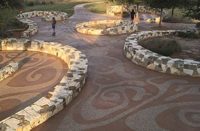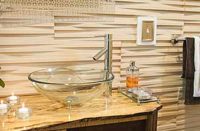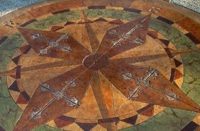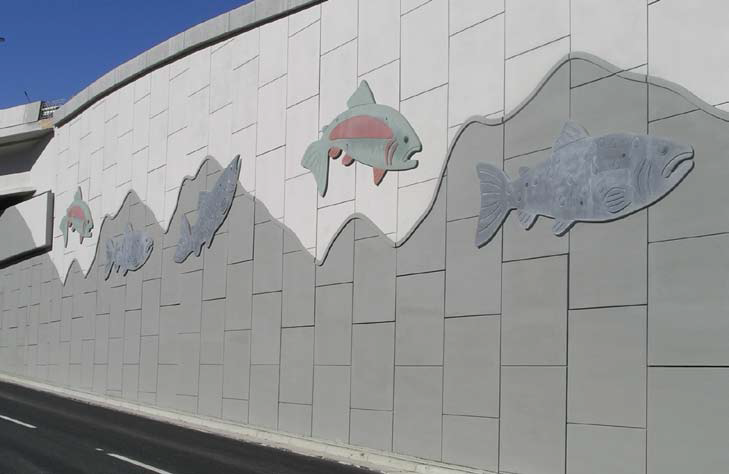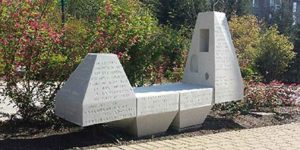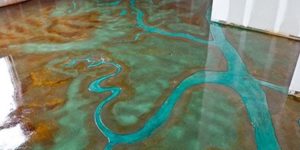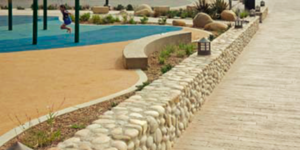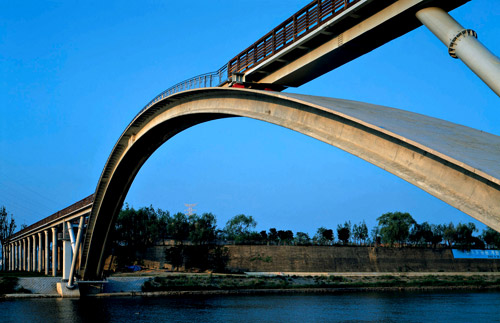
Lightweight and ultra-high-performance, fiber-reinforced Ductal offers advantages over traditional construction materials in interior and exterior applications: strength, durability, aesthetics and ductility.
Let’s say you have a vision dancing in your head of 144 trout flipping, flopping, leaping and diving alongside a busy thoroughfare in a major city. That would make you artist Violet Costello, who, along with partner Bob Thomasson, created “Jumping Trout,” an attention-grabbing dimensional art display currently being installed on retaining walls in Calgary, Alberta.
The fish represent the catch of the day in the nearby Bow River, so it all makes sense — except for the part where the pair had to figure out how to create an artscape that would be aesthetically pleasing today and still tickle viewers’ fancy after years of weather and traffic punishment. Oh, and it might be a good idea to come up with a sensible way to actually get the trout on the walls.
Ductal came through on all counts.This new kind of concrete is distributed through Lafarge North America. Lightweight and ultra-high-performance, fiber-reinforced Ductal offers at least four advantages over traditional construction materials in many interior and exterior applications: strength, durability, aesthetics and ductility.
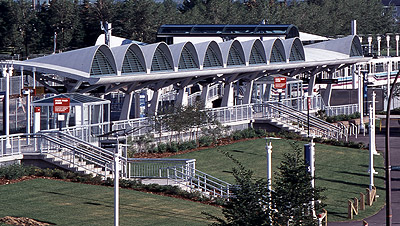
Take a closer look
At up to ten times the strength of conventional concrete, Ductal is more in a class with steel. It has up to 30,000 psi of compressive strength rather than the 7,000 psi or less of standard concrete. The outstanding strength-to-weight characteristic means that it can be sliced sliver-thin and still hold up.
How thin? Consider that the Ductal-constructed Footbridge of Peace, with its 400-foot span over the Han River in South Korea, transports pedestrian and bicycle traffic along a deck that’s just 1 1/4-inch thick. And that the Shawnessy LRT Station in Calgary features a unique Ductal roof arrangement that’s a slender 3/4-inch thickness.
As for the “Jumping Trout,” each sleek fish averages a couple inches in depth and, though nearly 15 feet long, weighs in at a relatively puny 850 pounds.
“Regular concrete would have been big, clunky, cumbersome things to work with,” says Costello. “With Ductal, our fish were thin and light.”
Ductal is durable. In “Jumping Trout,” we’re talking about an installation that must stand up to rain, snow, ice, sun, wind and vehicular exhaust. Ductal, highly resistant to abrasion, corrosion and freeze-thaw, was once again the ideal choice.
In contrast to traditional concrete, “the pores are smaller and discontinuous,rdquo; says Vic Perry, Lafarge North America’s vice president and general manager for the Ductal product line.
Smaller pores make the material more resistant to penetration by salt, moisture and chemicals. If it gets in, fluids can’t join networks of pores for long-term pooling. Then there’s that handy “self-healing” feature. If water manages to penetrate the surface it combines with unhydrated cement, reactivating the hydration process and pretty much acting as its own internal sealer.
The product’s surface hardness allows it to shrug off the effects of abrasion. No wonder Ductal has found service as anchors for stabilizing an aging seawall in Isla de la Reunion, off the eastern coast of Africa.
Ductal earns its name
Standard concrete is too brittle to bend under pressure. When it overstresses, it breaks. Ductal, on the other hand, earned its name for its ductility — the ability to flex. Not only does this enable designers to incorporate grace and elegance into their work, but it reduces the risk of sudden failure.
Of course, aesthetics are where the rubber meets the road for designers. “We got very much what I saw in my mind,” says Costello of the concrete casting and the coloration process done in collaboration with Lafarge’s Alberta Precast team.
The work required subtle variations of color due to the fact that the upper half of the canvas represents the sky. The lower half is water, the spheres divided by a sculpted wave. The fish above the wave would be more vibrantly hued than the critters swimming below.
Costello found the powdered pigment to be spot-on. “It was a quick process, and we got what we wanted,” she recalls.
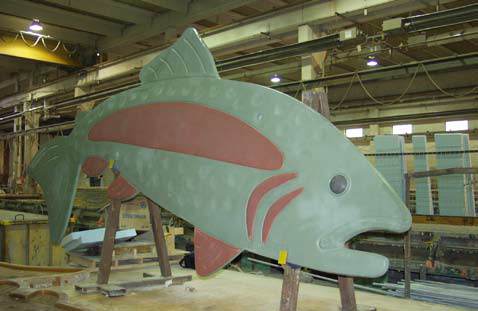 The trout were slated to be installed with the “wave” part of the structure. The wave and fish would be installed in panels directly onto the retaining wall that serves as the project’s canvas. That meant each fish would have to be segmented. But when the artists turned to the lighter-weight Ductal, they could create without segmentation and bolt each trout directly to the retaining wall in bas-relief fashion for a cleaner, more eye-popping effect.
The trout were slated to be installed with the “wave” part of the structure. The wave and fish would be installed in panels directly onto the retaining wall that serves as the project’s canvas. That meant each fish would have to be segmented. But when the artists turned to the lighter-weight Ductal, they could create without segmentation and bolt each trout directly to the retaining wall in bas-relief fashion for a cleaner, more eye-popping effect.
Ductal, commercially available in North America since 2001, is gaining steady acceptance with architects, civil engineers and designers. Perry sees a hot future in bridges, aesthetic architecture and even security. “Anywhere where there’s a potential for explosion or impact,” he says.
Meanwhile, it’s another sort of impact that artists and concrete distributors are looking for in Canada and the United States. They see a chance to make real waves, luring thousands of converts to Ductal.
www.imagineductal.com
